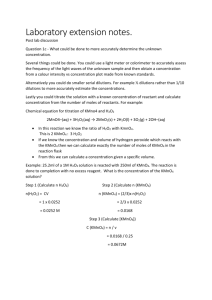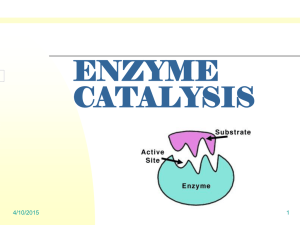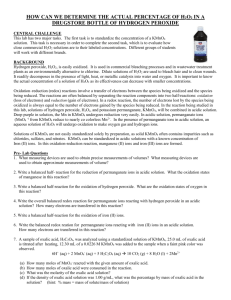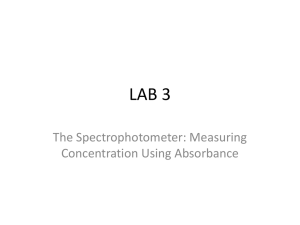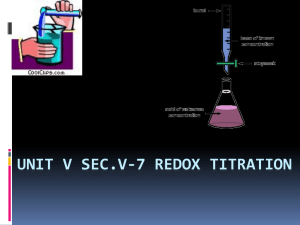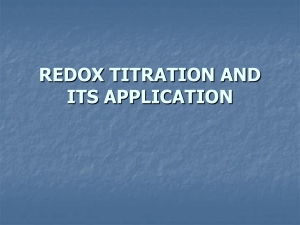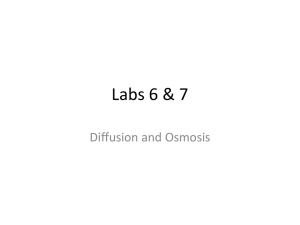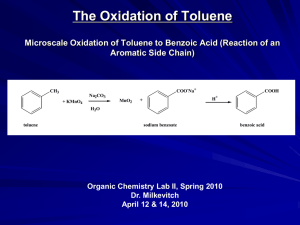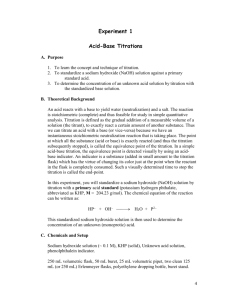14 Titration of H2O2
advertisement
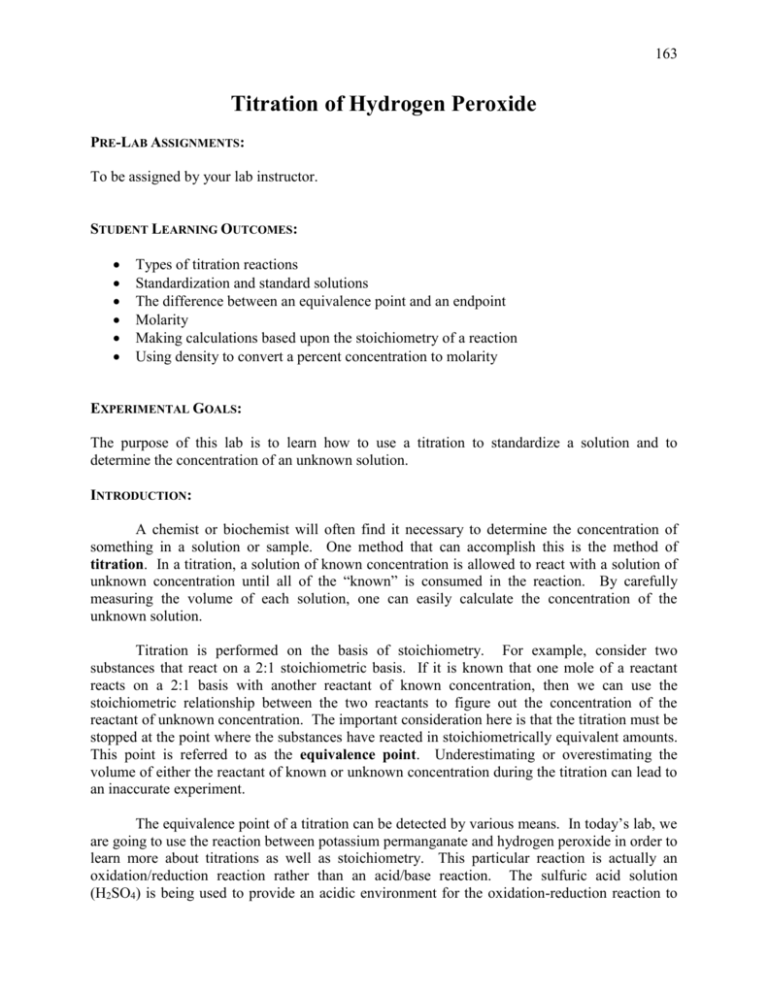
163 Titration of Hydrogen Peroxide PRE-LAB ASSIGNMENTS: To be assigned by your lab instructor. STUDENT LEARNING OUTCOMES: Types of titration reactions Standardization and standard solutions The difference between an equivalence point and an endpoint Molarity Making calculations based upon the stoichiometry of a reaction Using density to convert a percent concentration to molarity EXPERIMENTAL GOALS: The purpose of this lab is to learn how to use a titration to standardize a solution and to determine the concentration of an unknown solution. INTRODUCTION: A chemist or biochemist will often find it necessary to determine the concentration of something in a solution or sample. One method that can accomplish this is the method of titration. In a titration, a solution of known concentration is allowed to react with a solution of unknown concentration until all of the “known” is consumed in the reaction. By carefully measuring the volume of each solution, one can easily calculate the concentration of the unknown solution. Titration is performed on the basis of stoichiometry. For example, consider two substances that react on a 2:1 stoichiometric basis. If it is known that one mole of a reactant reacts on a 2:1 basis with another reactant of known concentration, then we can use the stoichiometric relationship between the two reactants to figure out the concentration of the reactant of unknown concentration. The important consideration here is that the titration must be stopped at the point where the substances have reacted in stoichiometrically equivalent amounts. This point is referred to as the equivalence point. Underestimating or overestimating the volume of either the reactant of known or unknown concentration during the titration can lead to an inaccurate experiment. The equivalence point of a titration can be detected by various means. In today’s lab, we are going to use the reaction between potassium permanganate and hydrogen peroxide in order to learn more about titrations as well as stoichiometry. This particular reaction is actually an oxidation/reduction reaction rather than an acid/base reaction. The sulfuric acid solution (H2SO4) is being used to provide an acidic environment for the oxidation-reduction reaction to 164 take place in. Finally, it is important to remember that balancing of some oxidation/reduction reactions is more complicated than other reactions because you have to balance mass (# of atoms of each element) as well as charge (related to the number of electrons lost/gained). 2KMnO4(aq) + 5H2O2(aq) + 3H2SO4(aq) 2MnSO4(aq) + K2SO4(aq) + 5O2(g) + 8H2O(l) In this particular reaction, we use the faint pink color of the permanganate ion as an indicator rather than using an additional dye to determine the end point. In essence, the permanganate in the KMnO4 solution acts as its own indicator. The Mn2+ ion is actually colorless, but when MnO4- is in excess, the solution will turn from colorless to pink, indicating that the equivalence point has been reached. When performing a titration, it is necessary to first determine the concentration of the known solution as accurately as possible. This process is referred to as standardization. For example, in this experiment, the titrant is an aqueous solution of potassium permanganate, KMnO4; however, solid KMnO4 contains traces of other impurities, such as MnO2, so a solution of known concentration cannot be made by simply measuring out a certain number of grams of KMnO4 and dissolving it in the appropriate amount of water. To determine the concentration of the KMnO4, it is titrated against something that can be measured accurately, such as solid oxalic acid, H2C2O4, whose mass can be measured very precisely. By using the stoichiometry of the standardization reaction, the concentration of the titrant solution can be determined. 2MnO4- + 5H2C2O4 + 6H+ 2Mn2+ + 10CO2(g) + 8H2O The level of accuracy afforded by graduated cylinders is not sufficient for a titration, so more accurate instruments must be used. Burets or pipettes typically are used in titrations. It is important to utilize the significant figures that a buret allows one to use. Burets are very accurate pieces of equipment. In order to determine the volume dispensed from a buret, the initial and final volumes are recorded and subtracted. (See the Introduction for the “Stoichiometry III: Titration of Vinegar” section for a more thorough discussion of the use of burets in titrations.) PROCEDURE: Safety Concerns Inform your instructor of any spills involving sulfuric acid, since this will require cleanup with a spill kit. Potassium permanganate is a strong oxidizing agent. Avoid contact with skin and clothing. If any significant contact does occur, make sure that you thoroughly flush the affected area with water and inform your instructor. Oxalic acid is a poison. Make sure you wash your hands at the end of the lab period. 165 A. Standardization of the KMnO4 unknown solution. [Note: In order to understand what color you are trying to avoid, place 20 mL of water in an Erlenmeyer flask and add one drop of KMnO4 from the buret. Mix and observe the color change that occurs. Add an additional drop of KMnO4 demonstrating the result of adding too much KMnO4. This is the color change that you are trying to avoid since it indicates that a large excess of KMnO4 exists in solution.] 1. Obtain 100 mL of KMnO4 from the bottle in the fume hood. 2. Carefully wash 2 Erlenmeyer flasks, and rinse them with deionized water. 3. Weigh out approximately 0.1 g of oxalic acid on a piece of weighing paper (to the precision of the balance), place it in an Erlenmeyer flask, and add 10 mL of 1.0 M H2SO4. Heat the solution to 80°C; if the temperature gets above 80°, cool it off using an ice bath. Make sure that all of the oxalic acid is dissolved before proceeding. Swirl the solution to make sure that no oxalic acid is clinging to the sides of the flask. 4. While you are heating the solution, have your partner obtain a buret from the equipment cart. Wash the buret with tap water first, and then with deionized water. Rinse the buret twice with 5 mL portions of the KMnO4 solution. Attach the buret to a ring stand using a buret clamp. Fill the buret with KMnO4 solution. 5. Record the initial volume of your buret, taking care to use the proper number of significant figures. 6. Once you have heated the solution to 80°C, remove the flask using some rolled up paper towels and place it under the tip of the buret. Place a piece of white paper underneath the flask to make the color change more easily seen. 7. Start adding the KMnO4 solution from the buret. Initially, the KMnO4 solution can be added freely. Swirl the flask after each addition. Once a color change starts to persist, slow down the addition of KMnO4. Eventually, you will have to add KMnO4 drop by drop. You are looking for a permanent color change (lasting greater than 30 seconds) to pink, indicating that there is excess permanganate ion. Keep in mind that it sometimes only takes one drop to over-titrate, so make sure that you are very careful at this step. You may use a small amount of deionized water from a squirt bottle to get a drop off the buret and into the flask. 8. Once you have reached the endpoint, record the final volume of your buret using the proper number of significant figures. 9. Repeat with the other Erlenmeyer flask, using approximately 0.1 g of oxalic acid. 10. Given the data from the steps above you will now be able to determine the concentration of the KMnO4 solution. 166 B. Concentration of H2O2 in a commercially prepared solution. 1. Obtain 5.00 mL of a hydrogen peroxide unknown solution (A or B) using a 5 mL volumetric pipette. Place this in a 50 mL volumetric flask (50.00 mL) and add water to bring the solution to the 50 mL mark. Mix the solution well, and add 10 mL of the solution to an Erlenmeyer flask, along with 15 mL of 1 M H2SO4. Repeat with a second Erlenmeyer flask (using the same unknown). 2. Titrate this solution as before using the KMnO4 solution, with the exception of NOT heating the solution prior to titrating. 3. Once your titration is complete, record your final volume. 4. Determine the mass of 5 mL of the undiluted hydrogen peroxide solution using a small beaker and a 5 mL volumetric pipette. You can use this measurement to determine the density of the hydrogen peroxide solution, and use it in your calculations for the lab. 5. From your data, you should be able to calculate the molarity of the KMnO4 solution and the concentration of the commercial H2O2 solution. Compare the known concentration of your hydrogen peroxide solution (3% w/w) to the concentration that you determined in the prelab. SAMPLE CALCULATIONS: Acid-base titration: 50.0 mL of 2.50 M H2SO4 was titrated with 75.0 mL of unknown NaOH solution. What is the molarity of the NaOH solution? (M= moles/L) 1. Write out the balanced equation: 2NaOH + H2SO4 Na2SO4 + 2H2O 2. Perform your calculations using the stoichiometry of the reaction: 0.0500 L H 2SO 4 2.50 moles H 2SO 4 2 mol NaOH 0.250 mol NaOH 1 L soln. 1 mol H 2SO 4 3. We can now perform our molarity calculation: M NaOH 0.250 mol NaOH 3.33 M 0.0750 L soln 167 Oxidation/reduction titration: 30.2 mL of a KMnO4 unknown solution was required to titrate 20.0 mL a 0.30 M solution of H2O2. What is the concentration of KMnO4? 1. Write out the balanced equation: 5H2O2 + 2KMnO4 + 3H2SO4 2MnSO4 + K2SO4 + 5O2 + 8H2O 2. Perform your calculations using the stoichiometry of the reaction: 0.0200 L H 2 O 2 0.30 moles H 2 O 2 2 mol KMnO 4 0.0024 mol KMnO 4 1 L soln. 5 mol H 2 O 2 3. We can now perform our molarity calculation: M KMnO4 0.0024 mol KMnO 4 0.079 M 0.0302 L soln 168 169 LAB REPORT Titration of Hydrogen Peroxide Name ________________________________ Date _________ Report Grade ______ Partner ________________________________ Section _________ A. Standardization of the KMnO4 unknown solution. 2MnO4- + 5H2C2O4 + 6H+ 2Mn2+ + 10CO2(g) + 8H2O First Determination Second Determination 1. Mass of oxalic acid, H2C2O4•2H2O ____________ ____________ 2. Moles of oxalic acid, H2C2O4•2H2O ____________ ____________ 3. Final reading of KMnO4 ____________ ____________ 4. Initial reading of KMnO4 ____________ ____________ 5. Volume of KMnO4 used (mL) ____________ ____________ 6. Volume of KMnO4 used (L) ____________ ____________ 7. Moles of KMnO4 (show calculations) ____________ ____________ 8. Molarity of KMnO4 (show calculations) ____________ ____________ 9. Average molarity of KMnO4 ____________ 170 B. Concentration of H2O2 in a commercially prepared solution. H2O2 solution used: _____ 2KMnO4(aq) + 5H2O2(aq) + 3H2SO4(aq) 2MnSO4(aq) + K2SO4(aq) + 5O2(g) + 8H2O(l) First Determination Second Determination 10. Final reading of KMnO4 ____________ ____________ 11. Initial reading of KMnO4 ____________ ____________ 12. Volume of KMnO4 used (mL) ____________ ____________ 13. Volume of KMnO4 used (L) ____________ ____________ 14. Moles of KMnO4 used (show calculations) ____________ ____________ 15. Moles of H2O2 titrated (show calculations) ____________ ____________ 16. Moles of H2O2 in undiluted sample ____________ ____________ 17. Molarity of H2O2 (show calculations) ____________ ____________ 18. Average molarity of H2O2 solution ____________ 19. Mass of 10 mL of H2O2 solution ____________ ____________ 20. Density of H2O2 solution (show calculations) ____________ ____________ 21. Weight % of H2O2 solution (show calculations) ____________ ____________ 22. Average weight % of H2O2 solution ____________ 171 Questions 1. Compare the difference between your determined concentration of H2O2 commercial solution and the advertised concentration of H2O2 commercial solution (3% w/w). 2. Based on your two standardizations of KMnO4, discuss the precision of your measurements. In particular, explain why you think your measurements were or were not precise. 172
